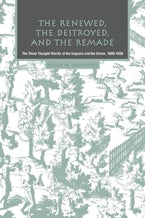For three decades, Native American history has been dominated by two major themes. The first is "The Cant of Conquest," the notion that all native peoples who came into contact with Europeans suffered devastating effects due to disease, alcohol, and warfare. However, the argument can be made that in some cases native peoples controlled their own fortunes, at least for awhile. The other dominant theme is the "The Contest of Cultures," the idea that Native American history needs to be examined in the context of dealings with Europeans. Europeans changed the Americas, but this approach concerns colonialism and colonists as well as Native Americans.
The Renewed, the Destroyed, and the Remade examines the changing worldviews of the Huron and the Iroquois in the first half of the seventeenth century, during a period of increasing European contact. From Samuel de Champlain’s armed encounter with the Iroquois, in 1609, to the dispersal of the Huron in the mid-seventeenth century, Carpenter’s book traces the evolving thought worlds of Iroquoian peoples.
The Iroquois and the Huron-peoples with an intertwined history and many cultural similarities-reacted differently to European contact. The Huron thought world began to change when the French initiated intense trade and missionary activity early in the seventeenth century. French missionary efforts resulted in a split within the Huron nation between traditionalists and Christian converts. By contrast, the Iroquois were interested primarily in trade with the newcomers. The Iroquois, like the Huron, accepted European trade goods, but unlike the Huron, they rejected European religion.
The Renewed, the Destroyed, and the Remade differs from other works of Native American history on several counts. Native American historiography has not been overly comparative. This work is a comparative history of two culturally similar Native American nations. It also differs in that, rather than another history of Native-European contacts, it is an Indian-centered history.

